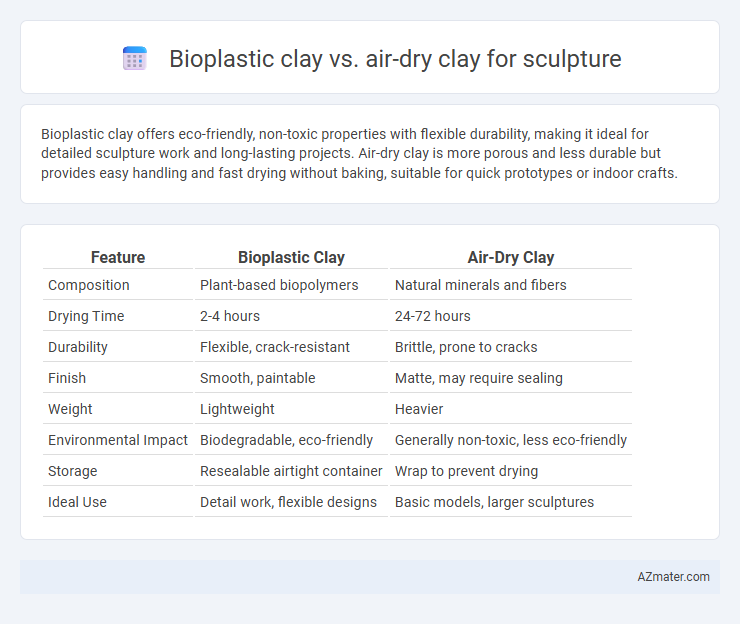Bioplastic clay offers eco-friendly, non-toxic properties with flexible durability, making it ideal for detailed sculpture work and long-lasting projects. Air-dry clay is more porous and less durable but provides easy handling and fast drying without baking, suitable for quick prototypes or indoor crafts.
Table of Comparison
| Feature | Bioplastic Clay | Air-Dry Clay |
|---|---|---|
| Composition | Plant-based biopolymers | Natural minerals and fibers |
| Drying Time | 2-4 hours | 24-72 hours |
| Durability | Flexible, crack-resistant | Brittle, prone to cracks |
| Finish | Smooth, paintable | Matte, may require sealing |
| Weight | Lightweight | Heavier |
| Environmental Impact | Biodegradable, eco-friendly | Generally non-toxic, less eco-friendly |
| Storage | Resealable airtight container | Wrap to prevent drying |
| Ideal Use | Detail work, flexible designs | Basic models, larger sculptures |
Introduction to Bioplastic Clay and Air-Dry Clay
Bioplastic clay is an eco-friendly, biodegradable modeling material made from renewable plant-based ingredients, offering a non-toxic and flexible alternative to traditional sculpting clays. Air-dry clay, composed mainly of natural minerals and water, hardens without baking by absorbing ambient moisture, making it convenient for home and educational projects. Both materials provide versatile sculpting options, but bioplastic clay is favored for sustainable art practices, while air-dry clay is valued for its ease of use and accessibility.
Composition and Eco-Friendliness
Bioplastic clay is primarily composed of renewable plant-based materials such as starches and cellulose, making it biodegradable and eco-friendly compared to traditional air-dry clay, which often contains synthetic polymers and additives. Air-dry clay hardens through moisture evaporation but may release microplastics or chemicals into the environment, whereas bioplastic clay decomposes more naturally without harmful residues. Choosing bioplastic clay supports sustainability by reducing reliance on non-renewable resources and minimizing environmental impact during and after use.
Sculpting Experience and Workability
Bioplastic clay offers superior flexibility and smoothness, allowing artists to easily shape intricate details and make adjustments during the sculpting process. Its consistent moisture retention prevents cracking and ensures a longer workable time compared to air-dry clay, which can harden quickly and become brittle. Air-dry clay is lightweight and convenient but may require faster sculpting techniques and additional sealing to maintain durability.
Drying Time and Curing Process
Bioplastic clay typically requires a shorter drying time compared to air-dry clay, often drying within hours depending on thickness, while air-dry clay can take 24 to 72 hours or more to fully dry. The curing process for bioplastic clay often involves baking or heat setting for durability and strength, whereas air-dry clay hardens simply by exposure to air, sometimes resulting in a more brittle finish. Artists prefer bioplastic clay for quicker project turnaround and enhanced flexibility after curing, while air-dry clay is favored for its ease of use and natural setting without additional tools.
Texture and Surface Finish Comparison
Bioplastic clay offers a smooth, pliable texture that remains flexible even after curing, ideal for detailed sculpting and a glossy surface finish. Air-dry clay provides a coarser, grainier texture that can be sanded and painted after drying but typically results in a matte, less polished surface. Artists seeking a refined, durable finish often prefer bioplastic clay, while air-dry clay suits projects emphasizing a natural, raw aesthetic.
Durability and Longevity of Sculptures
Bioplastic clay offers superior durability and longevity for sculptures due to its resistance to cracking, water, and environmental factors, ensuring the artwork maintains its integrity over time. Unlike air-dry clay, which tends to be more porous and fragile, bioplastic clay provides enhanced flexibility and resilience against wear and tear. Sculptors seeking long-lasting, durable pieces often prefer bioplastic clay for its ability to withstand handling and display without significant deterioration.
Suitability for Detailed Sculpting
Bioplastic clay offers superior suitability for detailed sculpting due to its smooth texture and flexibility, allowing artists to achieve fine, precise details without cracking or drying prematurely. Air-dry clay is less ideal for intricate designs as it tends to harden quickly, making it more prone to surface cracking and limiting the time available for detailed work. For sculptures requiring elaborate, delicate features, bioplastic clay provides enhanced workability and durability during the sculpting process.
Painting and Finishing Options
Bioplastic clay offers a smooth, non-porous surface ideal for detailed painting with acrylics, allowing vibrant colors and a glossy finish after sealing. Air-dry clay, being porous and more absorbent, requires thorough priming to prevent paint absorption and often benefits from sealing with varnish or polyurethane for durability. Both clays accommodate various finishes, but bioplastic clay generally delivers sharper detail retention and easier surface preparation for professional-grade painting results.
Cost and Accessibility
Bioplastic clay typically involves higher costs due to its environmentally friendly materials and limited availability in specialized stores or online. Air-dry clay remains more accessible and budget-friendly, widely found in craft stores with various brands offering affordable options. Sculptors weighing project expenses often prefer air-dry clay for its cost efficiency and ease of purchase.
Conclusion: Choosing the Ideal Clay for Sculpture
Bioplastic clay offers eco-friendly benefits and greater flexibility, making it ideal for artists prioritizing sustainability and durability in their sculptures. Air-dry clay provides ease of use and accessibility without the need for kilns or ovens, perfect for beginners and simple projects. Selecting the ideal clay depends on balancing environmental impact, project complexity, and intended longevity of the artwork.

Infographic: Bioplastic clay vs Air-dry clay for Sculpture
 azmater.com
azmater.com